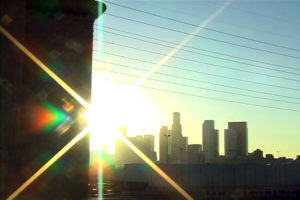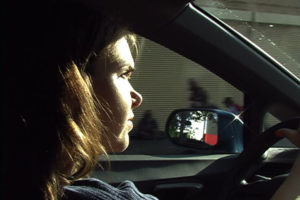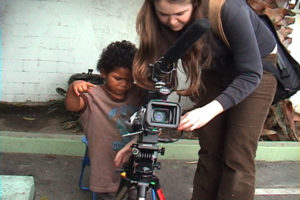Director’s Statement
 It started for me many years ago, when I was a little girl. Growing up in Los Angeles, riding around in the back of my parents’ car, I always noticed homeless people living on the streets. I didn’t know why they were out there – cold, hungry and alone — and I was on the other side: with food to eat, a bed to sleep in, protected by the love of my parents. Despite our immediate differences I felt a strong connection to these people whom I had never met.
It started for me many years ago, when I was a little girl. Growing up in Los Angeles, riding around in the back of my parents’ car, I always noticed homeless people living on the streets. I didn’t know why they were out there – cold, hungry and alone — and I was on the other side: with food to eat, a bed to sleep in, protected by the love of my parents. Despite our immediate differences I felt a strong connection to these people whom I had never met.
As I got older the connection I had felt since childhood intensified. When I was 23 years old, I took out a loan and bought a video camera. I spent every weekend on the streets, doing interviews with any homeless person who would talk to me. As I did more interviews, my instincts got better—but my desire to explore the darker and more dangerous areas of homelessness grew.
Skid Row was a part of Los Angeles I had only heard of; fifty blocks packed tightly in the heart of downtown with the highest concentration of homeless people was undoubtedly a place I had to see.
 Driving down there for the first time felt as if I had descended into hell. The streets of my native city resembled a third world country. There were no civilians. The sidewalks were overrun with the homeless. People slept in tents, on the streets, in the sewer. They were smoking crack and shooting heroin in broad daylight. There were mentally ill people wandering around helplessly lost in the haze of their disease, without friends or family to guide them.
Driving down there for the first time felt as if I had descended into hell. The streets of my native city resembled a third world country. There were no civilians. The sidewalks were overrun with the homeless. People slept in tents, on the streets, in the sewer. They were smoking crack and shooting heroin in broad daylight. There were mentally ill people wandering around helplessly lost in the haze of their disease, without friends or family to guide them.
Despite the apocalyptic landscape, I found myself completely captivated and enthralled and something inside of me changed that day.
I began meeting incredible people on Skid Row who showed me the way and the lay of the land. I encountered people in such extreme situations that I had only read about, but never imagined to be living in my city.
Despite the wide spectrum of problems that brought all of them to the streets it was their similarities I found myself consumed with. They were all suffering deeply in ways I had never known, each of them in a place where they could no longer help themselves. It dawned on me that we live in a society, and a country, where we tend to look down on those who are helpless, those who are in need. We say that if people want help badly enough they can get it. As I began to learn more about these people’s lives and hear their stories, I saw that so many of them were battling deep psychological wounds and physical limitations that prevented them from getting out of their respective situations on their own. This idea that everyone can help themselves if they want it badly enough was quickly shattered for me.
 Over time I found that the dozens of interviews I was doing had crystallized into meaningful relationships with a handful of homeless people throughout my city. As I got to know these people more intimately they began asking me for help and I did whatever I could do to help them. Before I knew it all of my subjects were asking me for help.
Over time I found that the dozens of interviews I was doing had crystallized into meaningful relationships with a handful of homeless people throughout my city. As I got to know these people more intimately they began asking me for help and I did whatever I could do to help them. Before I knew it all of my subjects were asking me for help.
As I was confronted with the choice to help them, I began to understand the real problems they were facing. I found myself consumed, working within this secret world that few of my friends or family really even knew much about. I was in over my head but it felt like the only thing I was supposed to be doing.
I had an opportunity to help these people simply because I was a functioning and relatively privileged member of society. Because I cared enough to actively seek the help they were looking for and affect change, I was able to make a difference in their lives and in doing so I changed my own life. The experiences I had throughout filming this movie have touched me in ways for which I am eternally humbled and grateful.




